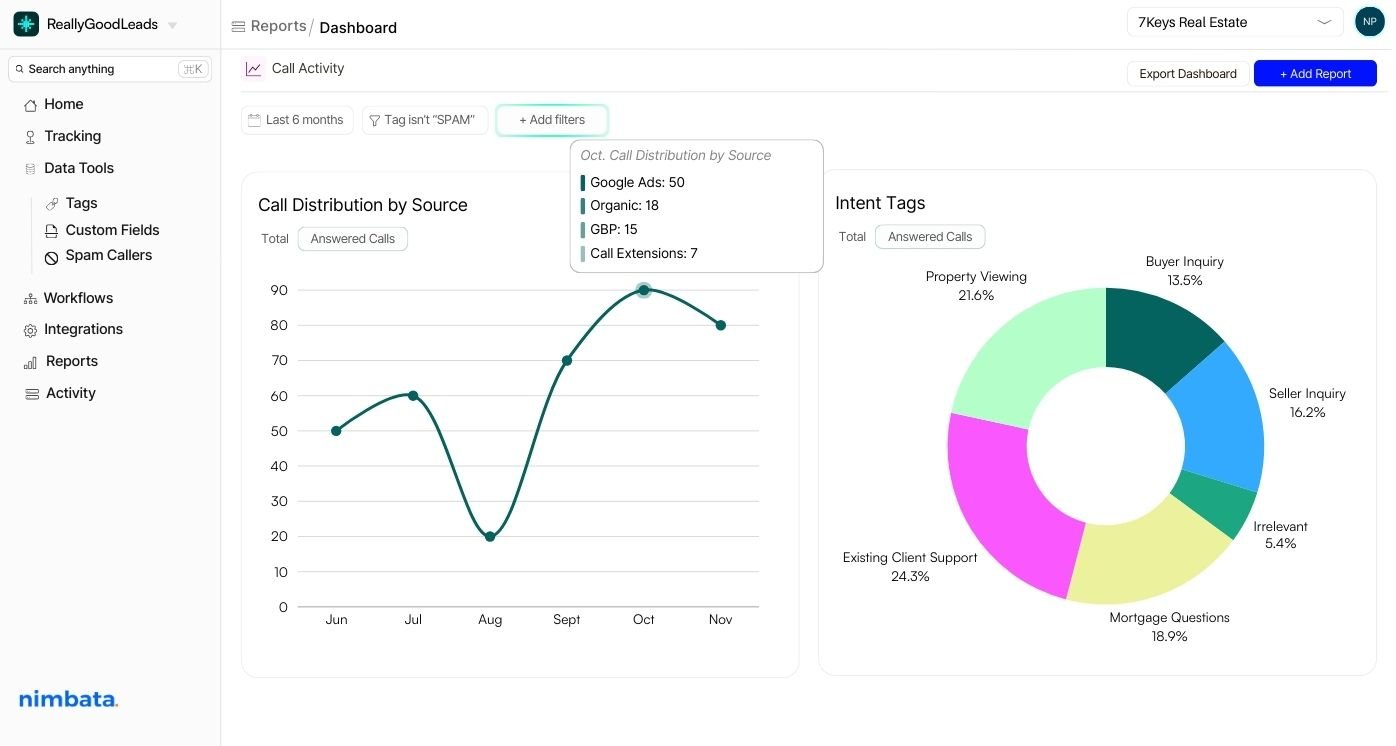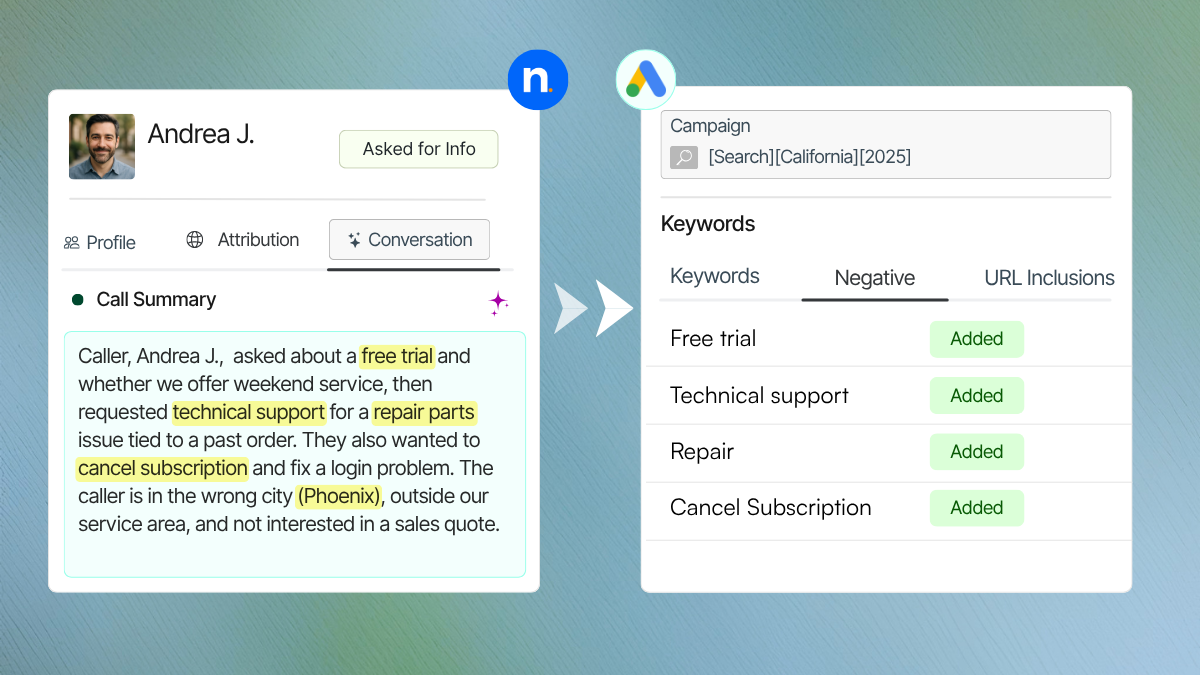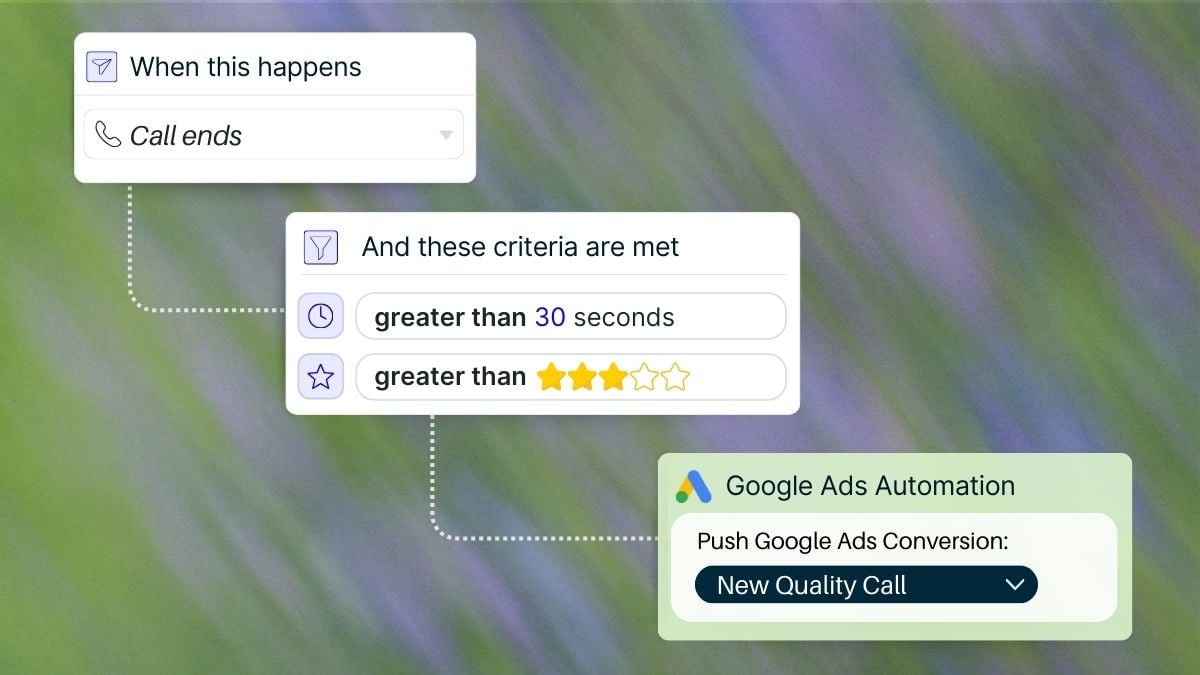Phonexa alternative overview: What is Phonexa?
Phonexa is a marketing automation software designed for performance marketers, lead generators, and affiliate networks. Call tracking is its core service along with lead distribution and email and SMS marketing tools. Phonexa’s call tracking platform, Call Logic, enables businesses to track inbound calls, attribute them to marketing efforts, and optimize campaigns based on call data.
Core features include:
- Dynamic Call Tracking & Attribution: Assign unique numbers to campaigns, keywords, or traffic sources (including offline), letting you link each incoming call back to the exact marketing source.
- Call Distribution & Smart Routing: Features like ping trees and IVR enable real-time call routing based on campaign rules, geography, or caller behavior.
- Lead Management & Predictive Modeling: Automates lead delivery and analyzes campaign effectiveness with predictive analytics.
- Full-Funnel Tools: Phonexa includes email & SMS marketing, click tracking, suppression lists, affiliate tools, and built-in accounting.
- Real-Time Reporting & Analytics: Get live dashboards and keyword-level attribution to identify top-performing campaigns.
Despite its features, many users find it complex and enterprise-focused, leading businesses and marketing looking at Phonexa alternatives. Also, the platform’s pricing structure and steep learning curve can create friction for those looking for straightforward, cost-effective call tracking solutions.
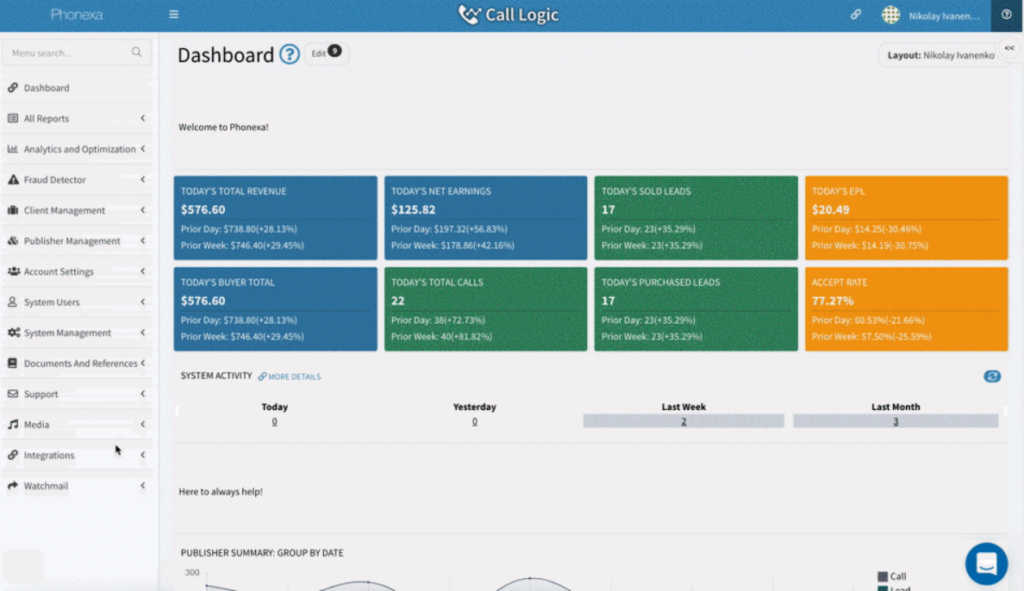
Why are users looking for a Phonexa alternative?
Phonexa is set apart for its end-to-end lead management. It follows leads throughout their journey, recording in detail every touchpoint until conversion. Users can also automate call flows, qualify leads in real-time, and gain granular insights into the performance of their marketing channels.
But, it’s a complex platform and has an enterprise-first approach, meaning that most businesses don’t fit in Phonexa’s model of operations. It’s a tradeoff that makes many marketers and businesses look inquisitively to other options.
Here are some common reasons marketers, agencies, and CMOs look for a Phonexa alternative:
1. Complexity and steep learning curve
Phonexa is an overkill for most businesses. It’s feature-rich yes and convenient for those looking to do call tracking, lead distribution, email, and SMS marketing at the same time. But for most, all these features, tools, and capabilities are a burden and add to the complexity of the platform.
2. Pricing that may feel out of reach
Phonexa’s pricing starts at around $100-250/month for Lite plans and jumps to $500/month+ for more advanced tiers. Many customers, even those suited for premium, feel the cost and onboarding fees aren’t justified unless you’re a high-volume, enterprise-level operation.
3. Limited integrations
While Phonexa includes integrations with Salesforce and HubSpot, users frequently request deeper API connectors and more plug-and-play connections.
4. Customer support
Phonexa gets rave reviews for its white-glove onboarding and dedicated support reps, but this level of support comes with trade-offs:
- That dependency can slow down self-service teams.
- It’s often essential just to get started.
Nimbata vs. Phonexa: At a glance
| Feature | Nimbata | Phonexa |
| Best Feature | -AI Call Summaries -Workflow Builder (Automations) -Configurable Native Integrations -Global Call Coverage -Manager Accounts -50+ Insightful Reports -Expert Support via Live Chat –Pay only per answered call | -Call Logic (Call Tracking Suite) -LMS Sync (Lead Management) -HitMetrix (Attribution & Analytics) |
| Best For | SMBs, Agencies, In-House Marketers, Business Owners | Large Enterprises, Affiliate Networks, Marketers with Complex Flows |
| Top Drawback | Low availability on AI features (for now) | High cost and bundled features that may go unused |
| Pricing | Starts at $35/mo + usage Pro plans up to $120/mo + usage | Starts at $250/mo + usage Enterprise plans up to $1000/mo |
| Customer Support | All users get: -Knowledge Base -Guided Demos & Live Walkthroughs -Ticket Support –Live Chat with Experts | -Knowledge Base -Guided Demos -Ticket Support -No live chat |
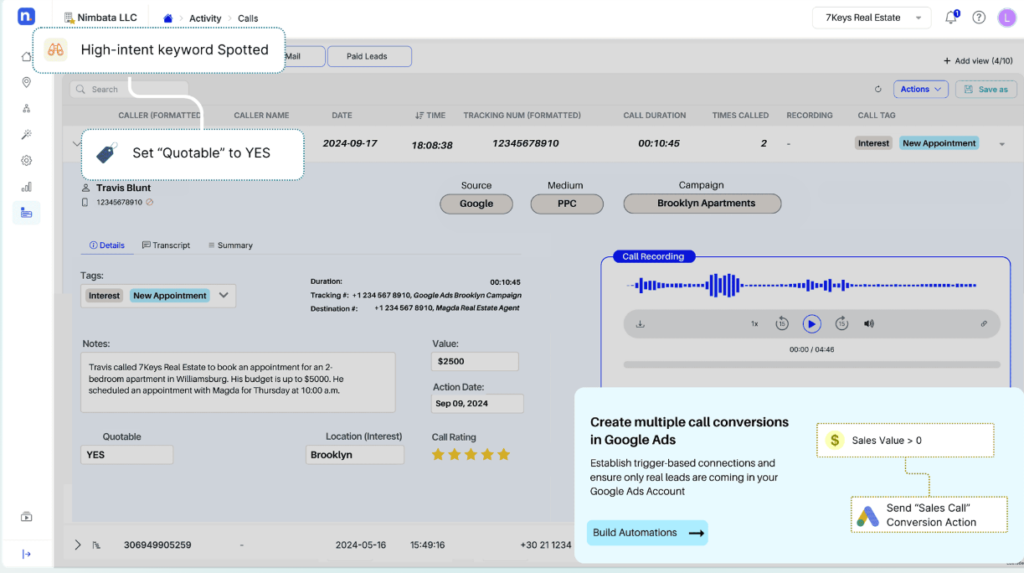
Different businesses have different needs, but all want their solutions to be simple and flexible.
Phonexa’s strength lies in its all-in-one approach. Tracking leads from first contact to conversion, automating workflows, and providing detailed, multi-channel attribution. However, this complexity comes at a cost, both in terms of pricing and usability.
Nimbata, on the other hand, removes the bloat and clutter by focusing on call tracking. It’s designed for marketers, agencies, and CMOs who want actionable insights without their views being blocked by unnecessary features. Nimbata is a lean call tracking tool with an intuitive platform for tracking and monitoring calls, attributing them to marketing efforts, and integrating seamlessly with existing tools. It does one thing but it does exceptionally well.
In essence, if you are looking for a sleek call tracking tool. that integrates effortlessly with your marketing stack, Nimbata is the smarter choice. If you’re an enterprise managing complex lead distribution systems and need multi-layered marketing automation, Phonexa might better suit your needs, provided you can stomach the cost and complexity.
Nimbata vs. Phonexa: Integrations
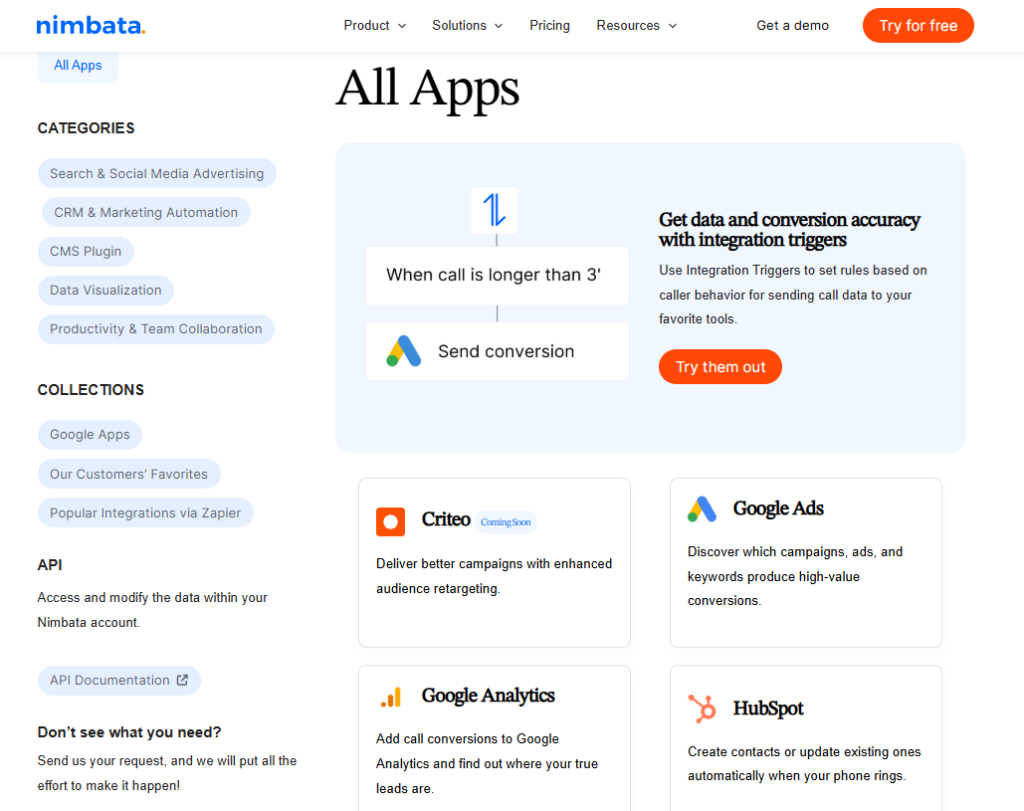
Nimbata and Phonexa follow different approaches when it comes to integrations.
Phonexa leans into its all-in-one ecosystem and offers native integrations with a limited range of major platforms, like HubSpot or Mailchimp. Its API does allow for custom integrations but it requires developer resources, which adds another layer of complexity and cost for businesses that already have to deal with a steep learning curve.
Nimbata takes the opposite approach; wide compatibility, no lock-ins. It’s built to blend seamlessly into the modern marketing stack:
- Native integrations with Google Analytics, Google Ads, and Facebook Ads.
- CRM integrations with HubSpot, Pipedrive, Zoho, and more.
- Zapier + Webhooks for 5,000+ additional app connections.
Instead of bending your workflows around your call tracking tool, Nimbata adapts to how you already work.
Phonexa locks you into its ecosystem.
Nimbata connects with the ecosystem you already use.
If you value flexibility, speed, and integration freedom, especially across ad platforms and CRMs, Nimbata is the smarter choice.
Nimbata vs. Phonexa: Analytics

Phonexa hinges on its core Call Logic to link phone calls to marketing campaigns, but its analytics depth really kicks in with HitMetrix, launched in mid‑2022. HitMetrix brings behavior tracking (session replays, heatmaps, click movement, scroll maps, goal funnels) and integrates tightly with Call Logic, LMS Sync, Lynx (click tracking), and more, to help enterprise users tie web behavior to call conversions help.
Nimbata takes a different route, providing laser-focused call analytics. With over 50+ dedicated reports, you get everything from call attribution and caller journey timelines to geography, source performance, missed-call patterns, and tagging trends. Custom dashboards and filters let you slice data by campaign, source, call outcome, duration, tags, new/repeat callers, and even combine views across brands and clients. Plus, exporting to Sheets, GA4, Google Ads, Looker Studio, or CSV ensures the analytics fit your workflow.
In essence:
- Phonexa delivers a full-funnel analytics suite with deep behavioral insights.
- Nimbata delivers crisp, flexible call analytics tailored to what marketers truly need.
If your priority is deep web-to-call linkage across sessions and UX changes, Phonexa + HitMetrix delivers. But if you want a clean, intuitive, powerful toolkit that helps you track, understand, and optimize call performance effortlessly, Nimbata is the smarter bet.
Nimbata vs. Phonexa: Lead management
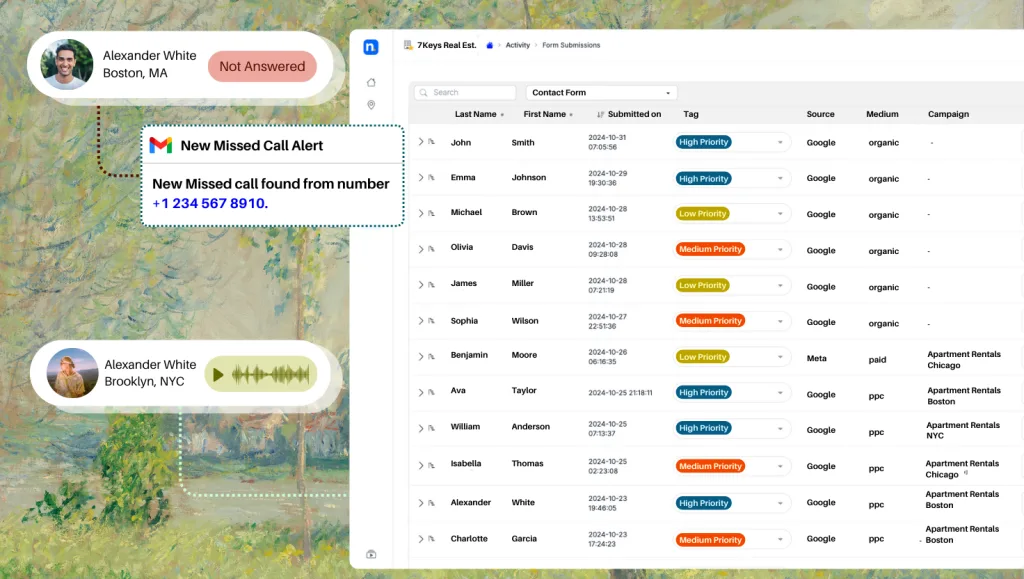
Leads are the bread and butter of marketing. They are the direct or indirect goal of every marketing effort and the tools you choose, should help you achieve the goal of generating high-quality leads.
Nimbata’s approach to lead management starts with capturing leads from calls or form submissions and then tracking and organizing them in a way that’s both intuitive and actionable.
Form tracking allows marketers to capture lead data directly from their websites, attributing each form submission back to its marketing source.
Nimbata simplifies lead qualification. Users can tag leads based on custom criteria, such as source, campaign, or quality. The tagging system is flexible, meaning you can tailor it to your unique sales process rather than conforming to platform rules.
Automation plays a central role in Nimbata’s lead management. Whether it’s routing leads to the right team members via call flows, syncing them to your CRM through integrations, or evaluating them with AI features and automations, Nimbata reduces manual work.
Phonexa takes a more enterprise-oriented approach to lead management. At the heart of its system is LMS Sync, a lead management solution designed to capture, distribute, and track leads across various channels. It’s built to handle high volumes of leads, making it ideal for affiliate marketers, large agencies, and lead generation businesses.
With LMS Sync, Phonexa allows users to qualify leads in real time, setting parameters to score and route them instantly. Lead flows can be automated to push prospects into specific pipelines, assign them to sales teams, or distribute them among affiliates based on pre-set rules.
However, the complexity of LMS Sync means it’s not a plug-and-play solution. Configuring lead flows, scoring models, and distribution rules requires time and technical expertise. Additionally, while Phonexa integrates with major CRMs like Salesforce and HubSpot, its ecosystem is relatively closed, pushing users toward its own suite of tools for email, SMS marketing, and more.
Nimbata vs. Phonexa: AI & Automations
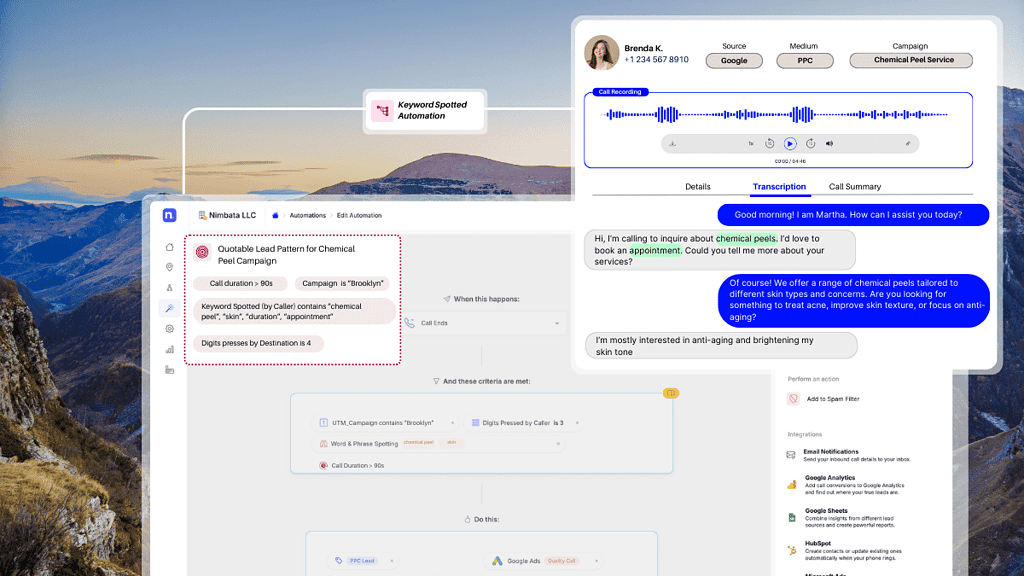
At the heart of Nimbata’s AI capabilities lies its Workflow Builder, a simple, no-code interface that allows users to create custom workflows tailored to their needs.
With Nimbata’s Workflow Builder automations, you can:
- Filter and qualify leads automatically based on pre-defined rules.
- Tag calls with relevant labels, such as “Qualified Lead,” “Follow-up Needed,” or “High Intent,” so sales teams know exactly where to focus.
- Push lead data to CRMs (like HubSpot, Pipedrive, or Zoho CRM) or Ads platforms (Google Ads, Facebook Ads) to continuously refine targeting algorithms.
To top it all off, Nimbata’s Conversational Intelligence and keyword and phrase spotting scans call transcripts to detect crucial terms that signal lead quality or customer intent. This eliminates the need for manual call reviews and surfaces insights instantly. Additionally, AI-generated call summaries condense lengthy conversations into actionable briefs. In short, Nimbata’s AI and automation tools are fast, flexible, and deeply integrated with the tools marketers already use.
Phonexa’s AI and automation suite leans heavily into its LMS Sync feature, a robust lead management system designed for enterprise-level automation. LMS Sync allows businesses to automate lead distribution, score leads in real time, and route calls or forms to the most appropriate sales reps.
Phonexa also offers advanced rule-based workflows that can sort and filter leads based on set criteria, useful for high-volume, multi-channel lead pipelines. Phonexa’s AI tools are tightly interwoven with its larger platform. Automations often rely on integrations within its ecosystem, which can limit flexibility for marketers using external CRMs or ad platforms without custom development.
Nimbata vs. Phonexa: Customer support
Nimbata takes a human-first approach, ensuring that users have direct access to real people, instead of bots or automated responses. Whether it’s through live chat, email, or scheduled calls, Nimbata’s support team is responsive and quick to provide practical solutions. Users can request live demos tailored to their specific use case, ensuring they get the most out of the platform. Additionally, Nimbata values customer feedback, actively listening to suggestions and frequently rolling out updates that reflect user needs.
Phonexa, while offering support options, leans more heavily on ticketing systems and knowledge bases. While these resources can be helpful, they often lack the immediacy and personalization that many businesses require, especially in the case of agencies with time-sensitive client campaigns.
Nimbata vs. Phonexa: Pricing
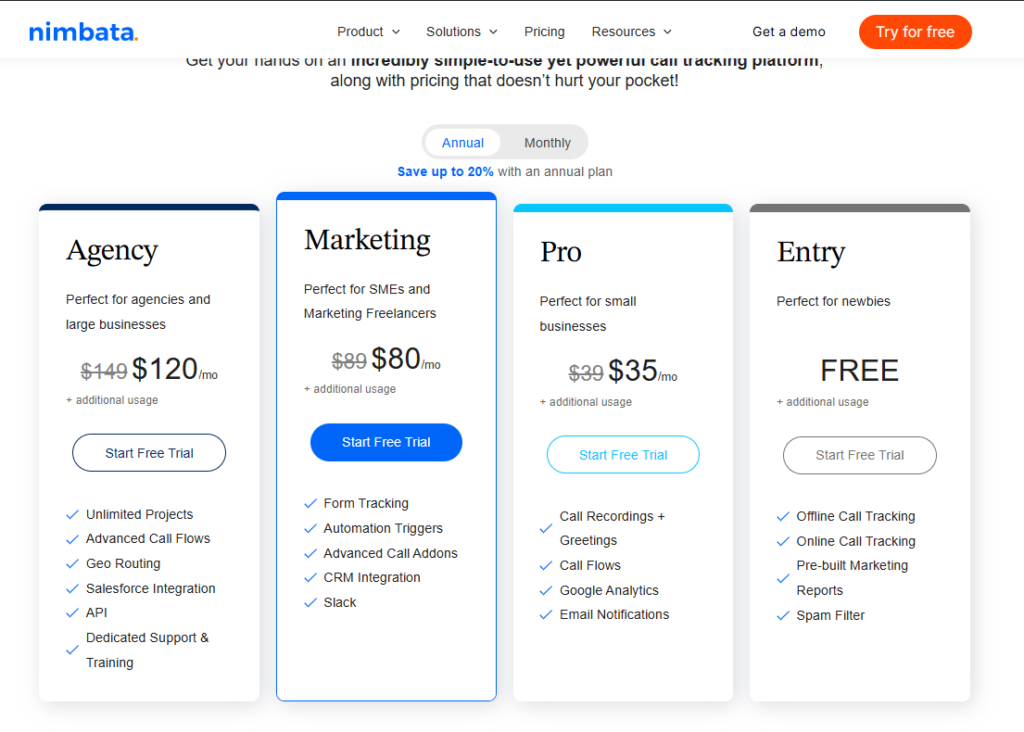
When it comes to pricing, Nimbata offers a more transparent and cost-effective solution compared to Phonexa.
Nimbata operates on a straightforward pay-as-you-go model, charging only for answered calls. This means you’re investing in genuine leads and customer engagements, ensuring your budget directly reflects the value you’re receiving.
Phonexa, on the other hand, uses a more complex, bundled pricing structure that combines multiple features beyond call tracking, like email marketing and lead distribution. While this may appeal to businesses seeking an all-in-one solution, it can result in higher monthly costs, even if you don’t fully utilize every feature.
Here’s a quick comparison between the two:
Nimbata pricing:
- Starting at $0/month: The Entry plan is free and includes essential call tracking features.
- Pay-per-answered-call: You’re charged only for answered calls, not per minute, making it cost-effective for businesses with varying call volumes.
- Flexible plans: Options range from $35/month to $120/month, with no setup fees or long-term contracts.
- Free trial: A 14-day trial is available to explore features before committing.
Phonexa pricing:
- Lite Suite: $250/month + $500 setup fee.
- Premium Suite: $500/month + $1,000 setup fee.
- Enterprise Suite: $1,000/month + $2,000 setup fee.
- Usage-based pricing: Additional charges apply for call minutes, emails, and other features, depending on usage.
Nimbata vs. Phonexa: Customer reviews
It would be useful to check out some reviews too. See what the users have to say about these two platforms.
Let’s check out Nimbata first.


And now, Phonexa.
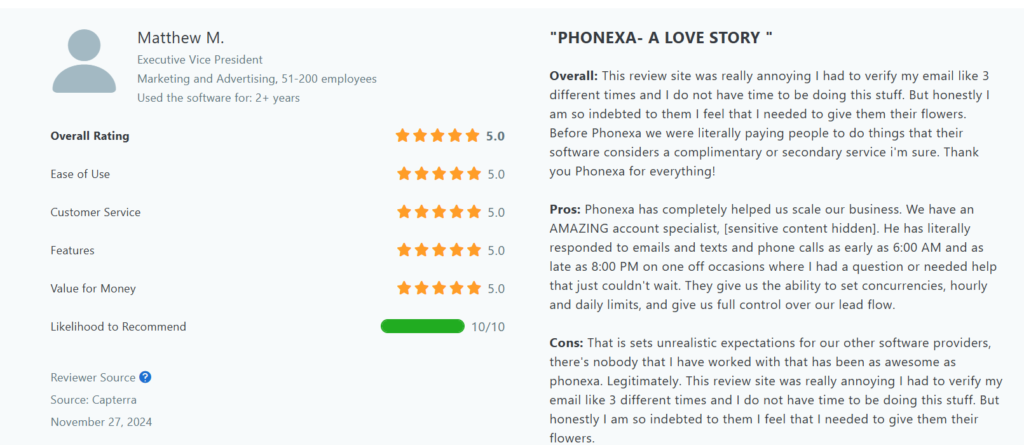
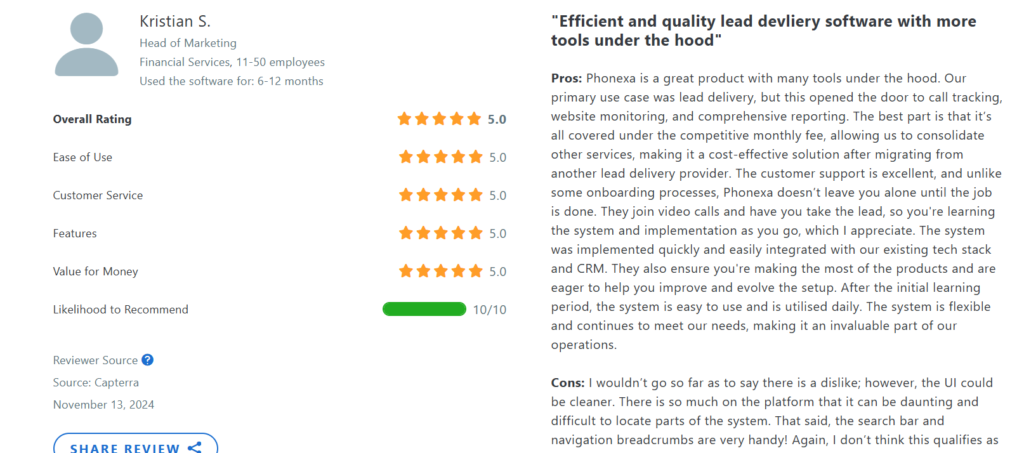
Other Phonexa alternatives
| Call Tracking Platform | Use Case | Free Trial | Paid Plans |
| Phonexa | Best call tracking lead management | Not available | Starts at $250/month + usage |
| Nimbata | Best overall call tracking for attributing, analyzing & managing leads | 14-day free trial | Starts at $35/month + usage costs |
| CallRail | Best call tracking for analyzing call data | 14-day free trial | Starts at $50/month + usage costs |
| Invoca | Best call tracking for conversation analytics | Not available | Not disclosed |
| CallTrackingMetrics | Best call tracking for inbound and outbound call tracking | Not available | Starts at $79/month + usage costs |
| WhatConverts | Best call tracking for lead attribution | 14-day free trial | Starts at $30/month + usage costs |
| Ringba | Best call tracking for pay per callers | Free trial available | Starts at $147/month + usage costs |
Let’s explore now some additional Phonexa alternatives.
CallRail: The best Phonexa alternative for analyzing call data
Best For: Big Agencies & Enterprises
Price Starting at: $50/month
Use case: Best call tracking for analyzing call data

CallRail stands out as a go-to call tracking platform for businesses seeking a feature-rich solution. It provides essential tools like call recording, dynamic number insertion, and in-depth analytics. Renowned for its user-friendly interface, CallRail also integrates effortlessly with a wide range of marketing and CRM platforms, making it a flexible choice for agencies and marketers aiming to streamline their call tracking efforts.
- Key Terms Spotted Report: CallRail provides the user with reports on the keywords and phrases most used during calls. These reports also highlight which calls that featured those keywords, can be marked as qualified leads.
- Sentimental Analysis: Callrail’s sentiments feature analyses incoming calls. This reduces manual labor and makes listening to call transcripts obsolete. It also shows the overall sentiment of a call and helps the user make better decisions based on them.
- Copilot: Callrail’s Copilot allows users to view valuable information about a caller, before they even pick up the phone. It makes use of the caller ID to generate the necessary info.
| Tool | CallRail | Phonexa |
| Best Feature | -Keyword Spotting -Sentimental Analysis -Copilot | -Call Logic -LMS Sync -HitMetrix |
| Best For | Big Agencies & Enterprises | Large Enterprises, Agencies, Marketers with Complex Needs |
| Most Important Con | -Many hidden costs and extra costs for add-ons & Integrations (e.g. Call-flow Steps, SalesForce Integration) -Users have reported being ghosted by support -Not available in the EU. | High pricing structure with bundled features |
| Pricing | $50/month to $150/month, extra for usage | $250/month + usage |
| Customer Support | -Knowledge base -Ticket-based Support -Demo | -Knowledge base -Demo -Ticket Submission |
And here are some reviews.


Invoca: The best Phonexa alternative for conversation analytics
Best For: Big agencies, enterprises, and contact centers.
Price Starting at: Not disclosed.
Use case: Best call tracking for conversation analytics

Invoca caters to enterprise businesses, emphasizing AI-powered call tracking and analytics. With advanced conversation intelligence, it analyzes call data to uncover patterns and opportunities. What sets Invoca apart is its capability to manage sophisticated call tracking requirements, delivering actionable insights into customer conversations and behaviors.
Here are its main benefits:
- AI-Powered Analytics: Invoca’s AI-Powered conversation analytics allows for deep views into customer interactions. Users can receive valuable data from them and plan their sales strategy accordingly. The AI can also score an agent’s performance, create transcripts, and automate many processes and actions.
- Marketing Reports: Invoca can generate reports that provide full attribution for every conversion achieved through phone. Marketing teams thus gain an edge in their planning and strategy.
| Tool | Invoca | Phonexa |
| Best Feature | -AI Conversational Analysis -Robust Marketing Reports | -Call Logic -LMS Sync -HitMetrix |
| Best For | Big Agencies, Enterprises, Contact Centers | Large Enterprises, Agencies, Marketers with Complex Needs |
| Most Important Con | Many advanced features are paid extra as an addon | High pricing structure with bundled features |
| Pricing | Not disclosed | $250/month + usage |
| Customer Support | Not disclosed | -Knowledge base -Demo -Ticket Submission |
Let’s see some reviews now.


CallTrackingMetrics: The best Phonexa alternative for inbound and outbound call tracking
Best For: Big Agencies & Enterprises
Price Starting at: $79/month
Use case: Best call tracking for inbound and outbound call tracking

CallTrackingMetrics delivers a comprehensive set of features, from call tracking and recording to in-depth analytics. What makes it stand out is its flexible reporting and powerful automation options. Designed to scale, it caters to businesses of all sizes, helping you fine-tune your marketing strategies with actionable call data.
- Friendly User Interface: Many customers find CalltrackingMetrics’ UI easy to use. They consistently mark it down as very friendly, simple and efficient. It allows them to perform tasks fast and without any difficulties.
- Integrations: CallTrackingMetrics comes equipped with a vast array of integrated software. Google Analytics, Slack, Zoom and dozens of other apps and tools are available. Users can easily transfer data from one platform to another. This improves their workflow, removes time-consuming tasks and generally makes work easier. CallTrackingMetrics can also integrate with a variety of CRMs such as Hubspot, Pipedrive and Mailchimp.
- Ease of Use: User reviews agree that CallTrackingMetrics is easy to install and start operating. It doesn’t require any particular technical expertise. People with different levels of digital skills can learn to use it in a reasonable amount of time. Thus, CallTrackingMetrics saves them lots of effort and doesn’t waste any more work hours than needed.
| Tool | CallTrackingMetrics | Phonexa |
| Best Feature | -Smart Router -AskAI -Form Reactor | -Call Logic -LMS Sync -HitMetrix |
| Best For | Enterprises with huge call volumes | Large Enterprises, Agencies, Marketers with Complex Needs |
| Most Important Con | Many advanced features are locked behind more expensive plans | High pricing structure with bundled features |
| Pricing | $79/per month + usage to $1999/per month + usage | $250/month + usage |
| Customer Support | For Every user: -Knowledge base -Live and recorded training -Ticket portal -CTM offers more support options to its higher plans | -Knowledge base -Demo -Ticket Submission |
Below are some customer reviews you might useful.


WhatConverts: The best Phonexa alternative for lead attribution
Best For: SMBs, Agencies, Inhouse Marketers, Business Owners
Price Starting at: $30/month
Use case: Best call tracking for lead attribution

WhatConverts goes beyond call tracking by capturing form submissions and live chats, giving marketers a complete picture of their lead generation efforts. With robust analytics and seamless integrations with top marketing platforms, it’s a powerful tool for those wanting to track and measure leads across multiple channels in one place.
- Chat tracking: WhatConverts captures complete chat transcripts alongside lead details, linking each chat back to its marketing source, campaign, or keyword. Chat events are sent directly to Google Analytics, helping you map conversion funnels and see which efforts drive engagement. Full chat tickets are stored with detailed marketing data for a clear view of each lead’s journey.
- Value leads: Assign and track lead value by integrating directly with your CRM. Use the Leads Dashboard to qualify leads, assign sales value, and track ROI for each campaign, giving you a clear picture of your marketing’s impact.
| Tool | WhatConverts | Phonexa |
| Best Feature | -Automated Spam Blocking -HIPAA Compliant Call Tracking -Chat Tracking | -Call Logic -LMS Sync -HitMetrix |
| Best For | SMBs, Agencies, Inhouse Marketers, Business Owners | Large Enterprises, Agencies, Marketers with Complex Needs |
| Most Important Con | Low availability on AI features | High pricing structure with bundled features |
| Pricing | $30/per month + usage to $160/per month + usage | $250/month + usage |
| Customer Support | Available to All Users: -Knowledge base Demo -Live Walkthrough -Ticket Submission -Live Chat | -Knowledge base -Demo -Ticket Submission |
Some interesting reviews are following.


Ringba: The best Phonexa alternative for pay-per-callers
Best For: Pay per Callers
Price Starting at: $147/month + usage
Best for: Best call tracking for pay-per-callers

Ringba is a call tracking and analytics solution built specifically for performance marketers and agencies. With advanced tools like real-time call tracking, dynamic number insertion, and in-depth analytics, it’s designed to enhance the effectiveness of call-driven campaigns. Its emphasis on performance marketing makes it an ideal choice for businesses aiming to refine and maximize their call-based strategies.
- Interactive Voice Response: Users can easily create interactive voice response trees that reduce labor costs. They can route calls by keywords, demographics, location, and many other parameters as well.
- Ring Tree: Ringba is integrated with the world’s largest call buyers. Users can access and bid on them in their own real-time marketplace. It’s completely no-code and can be scaled to no end.
- Instant Caller Profile: Ringba provides its users with data on the caller before they even pick up the phone to answer. There are no minimus and this data can be integrated with the IVRs to create a seamless routing experience.
Each Marchex alternative brings something unique to the table, whether it’s ease of use, advanced analytics, or specific integrations.
| Tool | Ringba | Phonexa |
| Best Feature | -Enhanced caller-level data -Ring Tree -Interactive Voice Response | -Call Logic -LMS Sync -HitMetrix |
| Best For | Pay per Callers | Large Enterprises, Agencies, Marketers with Complex Needs |
| Most Important Con | Ringba’s solution is targeted specifically on pay-per-callers & lead generation agencies managing huge affiliate networks. | High pricing structure with bundled features |
| Pricing | $147/month + usage | $250/month + usage |
| Customer Support | -Knowledge base -Phone Support -Demo | -Knowledge base -Demo -Ticket Submission |
Let’s check out some reviews now.


What do the users have to say?
Below, we have a table with the aggregate customer reviews for all solutions presented in this article.
| G2 | Capterra | TrustPilot | |
| Nimbata | 4.7 | 4.7 | 4.5 |
| Phonexa | 4.9 | 5.0 | – |
| CallRail | 4.6 | 4.5 | 4.3 |
| Invoca | 4.5 | 4.5 | 3.7 |
| CallTrackingMetrics | 4.5 | 4.6 | 3.3 |
| Ringba | 4.9 | 4.9 | – |
Takeaway
Simplicity, powerful features, and affordable pricing. These are the things that make Nimbata stand out as a top Phonexa alternative. It’s a lean, cost-effective tool designed to fit seamlessly into your existing marketing stack, offering robust analytics and AI-powered automation without the complexity of larger platforms.
If you’re considering Phonexa alternatives, here are some options that may suit different needs:
- CallRail: Best for agencies and enterprises seeking in-depth analytics and flexible integrations at a competitive price point.
- WhatConverts: Ideal for small to medium businesses looking to track not just calls, but also form submissions and live chats in one place.
- CallTrackingMetrics: Offers robust automation and flexible reporting, making it a great choice for large agencies managing high call volumes.
- Ringba: Perfect for performance marketers and pay-per-call agencies, with advanced features for real-time call tracking and interactive voice response systems.
Ultimately, whether you choose Nimbata or another platform, the key is to find a call tracking solution that aligns with your business’s needs, offering both simplicity and depth where it matters most.

